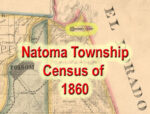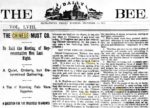The view above represents the fine and substantial bridge across the American River at Leslie’s Ferry. It was commenced in the spring of 1851 and completed in the month of September of the same year. It is the largest and most substantial structure of the kind in California, being 620 feet in length, 25 feet in width, and 30 feet above low water mark.









